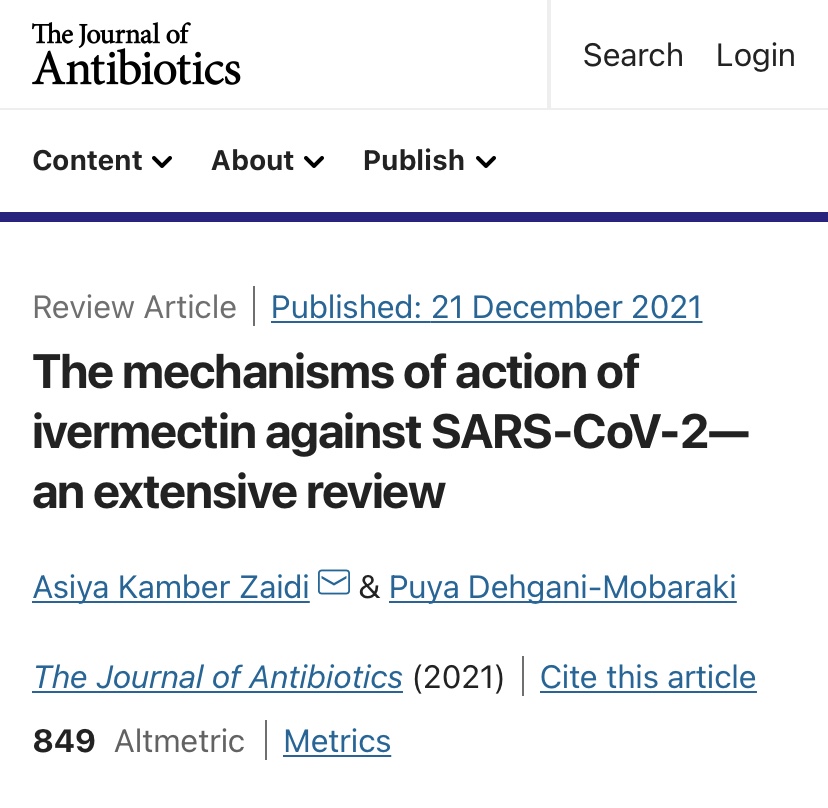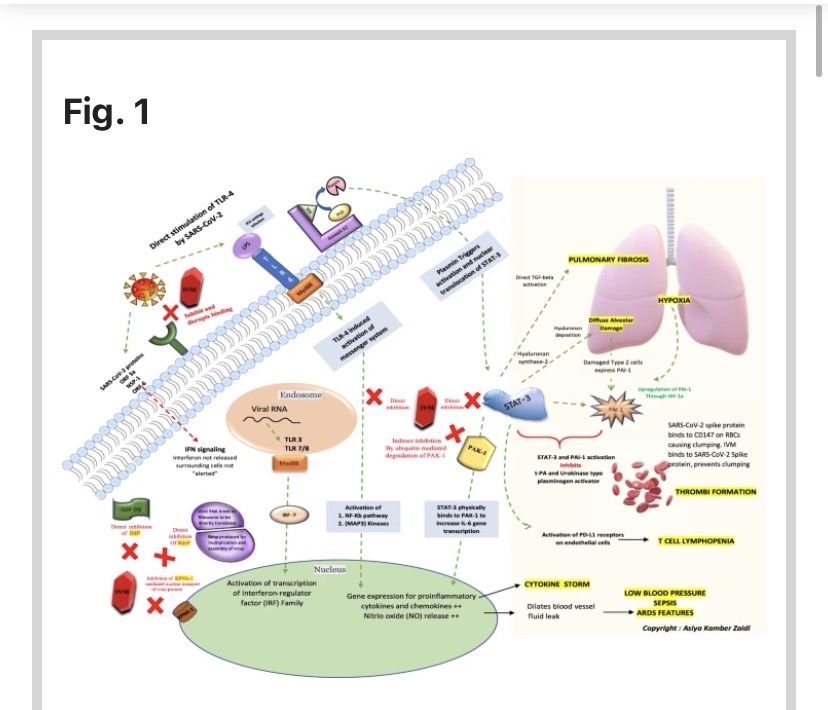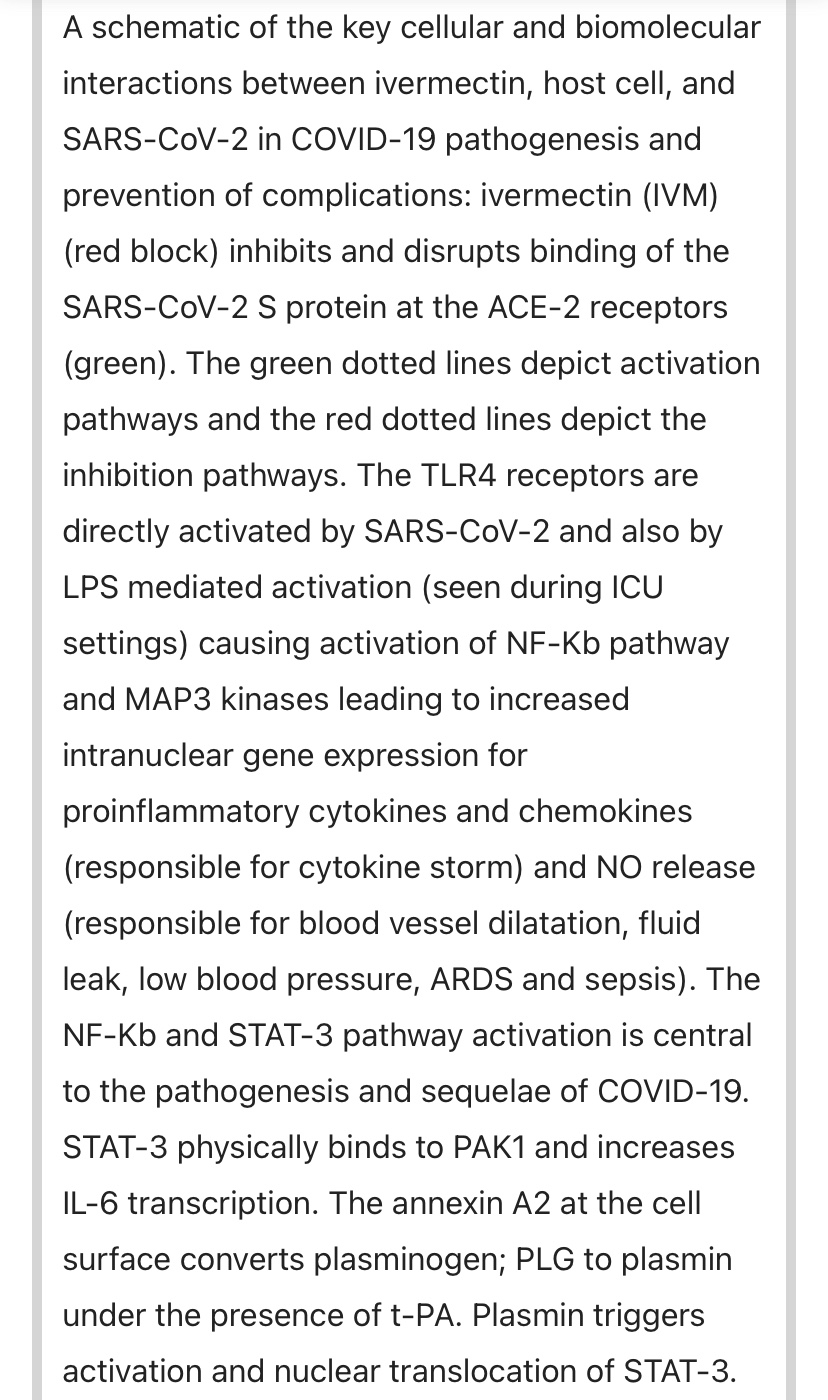
(Cliff Notes version from Nurse Claire: It’s never too early, and early is better, but it’s also never too late to take ivermectin. It works at all stages, and it is important to keep taking it as long as you are sick.)
Abstract
Considering the urgency of the ongoing COVID-19 pandemic, detection of new mutant strains and potential re-emergence of novel coronaviruses, repurposing of drugs such as ivermectin could be worthy of attention. This review article aims to discuss the probable mechanisms of action of ivermectin against SARS-CoV-2 by summarizing the available literature over the years. A schematic of the key cellular and biomolecular interactions between ivermectin, host cell, and SARS-CoV-2 in COVID-19 pathogenesis and prevention of complications has been proposed.
…
Results
Ivermectin as an antihelminth
Ivermectin has been approved as an antihelminthic [14]. It is a selective positive allosteric modulator at the glutamate-gated chloride channels found in nematodes and insects and acts by binding to these channels leading to chloride ion influx causing hyperpolarization of the cell and hence, dysfunction [15]…
In principle, a molecule can act as an antiviral drug if it “inhibits some stage of the virus replication cycle, without being too toxic to the body’s cells.” [20]
The possible modes of action of antiviral agents would include the following:
- (1)Inactivate extracellular virus particles.
- (2)Prevent viral attachment and/or entry.
- (3)Prevent replication of the viral genome.
- (4)Prevent synthesis of specific viral protein(s).
- (5)Prevent assembly or release of new infectious virions.
The role of ivermectin against the SARS-CoV-2 virus
The targets of activity of ivermectin can be divided into the following four groups:
A. Direct action on SARS-CoV-2
Level 1: Action on SARS-CoV-2 cell entry.
Level 2: Action on importin (IMP) superfamily.
Level 3: Action as an ionophore.
B. Action on host targets important for viral replication
Level 4: Action as an antiviral.
Level 5: Action on viral replication and assembly.
Level 6: Action on posttranslational processing of viral polyproteins.
Level 7: Action on karyopherin (KPNA/KPNB) receptors.
C. Action on host targets important for inflammation
Level 8: Action on interferon (INF) levels.
Level 9: Action on Toll-like receptors (TLRs).
Level 10: Action on nuclear factor-κB (NF-κB) pathway.
Level 11: Action on the JAK-STAT pathway, PAI-1, that could be involved with COVID-19 sequalae.
Level 12: Action on P21 activated kinase 1 (PAK1).
Level 13: Action on interleukin-6 (IL-6) levels.
Level 14: Action on allosteric modulation of P2X4 receptor.
Level 15: Action on high mobility group box 1 (HMGB1).
Level 16: Action as an immunomodulator on lung tissue and olfaction.
Level 17: Action as an anti-inflammatory.
D. Action on other host targets
Level 18: Action on plasmin and annexin A2.
Level 19: Action on CD 147 on the red blood cell (RBC).
Level 20: Action on mitochondrial ATP under hypoxia on cardiac function.
The direct “antiviral targets” may be useful in the early stages while the anti-inflammatory targets might be addressed in the later stages of the disease.
Direct action of ivermectin on SARS-CoV-2
Level 1: Action on SARS-CoV-2 cell entry
A study by Lehrer et al. observed that ivermectin docked in the region of leucine 91 of the SARS-CoV-2 spike protein and histidine 378 of the host cell ACE-2 receptor blocking its entry into the host cell [21]. In yet another study by Eweas et al., potential repurposed drugs such as ivermectin, chloroquine, hydroxychloroquine, remdesivir, and favipiravir were screened and molecular docking with different SARS-CoV-2 target proteins including S and M proteins, RNA-dependent RNA polymerase (RdRp), nucleoproteins, viral proteases, and nsp14, was performed. Ivermectin showed the following 5 important docking properties [22]:
- (1)Highest binding affinity to the predicted active site of the S glycoprotein (Moldock score −140.584) and protein–ligand interactions (Moldock score −139.371).
- (2)Considerable binding affinity to the predicted active site of the SARS-CoV-2 RdRp protein (Moldock score −149.9900) and protein–ligand interactions (Moldock score −147.608), it formed H-bonds with only two amino acids: Cys622 and Asp760.
- (3)Highest binding affinity (Moldock score −212.265) to the predicted active site of nsp14.
- (4)The highest binding affinity to the active site of the TMPRSS2 protein (Moldock score −174.971) and protein–ligand interactions (Moldock score −180.548). Moreover, it formed five H-bonds with Cys297, Glu299, Gln438, Gly462, and Gly464 amino acid residues present at the predicted active site of the TMPRSS protein.
- (5)The free binding energy of the spike protein (open) was higher in ivermectin (−398.536 kJ/mol) than remdesivir (−232.973 kJ/mol).
An in silico data analysis conducted by Choudhury et al. demonstrated that ivermectin efficiently utilizes viral spike protein, main protease, replicase, and human TMPRSS2 receptors as the most possible targets for executing its “antiviral efficiency” by disrupting binding. Since ivermectin exploits protein targets from both, the virus and humans, this could be responsible for its excellent in vitro activity against SARS-CoV-2 [23].



Thanks for this….now of the ‘captured’ pencil neck bureaucrats would learn something…
Let the fact-checks and calumny begin.
Diphenhdrimine and Lactoferin the protein in human and cows milk knocks out covids.